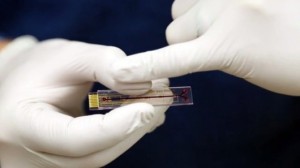Published study involved a demonstration of the MEDIC device’s ability to measure therapeutic drugs in animals, as well as human whole blood
Researchers at the University of California Santa Barbara (UCSB) are making rapid progress in designing a biosensor that can measure therapeutic levels of a prescription drug in real time within the patient. This technology has interesting implications for anatomic pathology and clinical laboratory testing.
The research team has developed a small electronic device that continuously tracks the level of medicines (doxorubicin and kanamycin) in an animal’s bloodstream. For pathologists and other physicians, this wireless tool can perhaps one day be used to help transform how drugs are chosen and monitored in patients.
In Vivo Device Designed to Monitor Concentrations of Therapeutic Drugs
About the size of a jumbo paper clip, the instrument is called MEDIC, which stands for Microfluidic Electrochemical Detector for In vivo Concentrations. In a story about these research findings, the UCSB Current reported that the MEDIC device can determine the concentrations of specific molecules in tiny amounts of human whole blood. Medic can do this continuously and in real time.
Should MEDIC work in humans the same way it works in animals, it may “revolutionize how medicines, such as anticancer compounds and antibiotics, are monitored and administered for life-threatening conditions,” noted a story published by Science, the journal of the American Association for the Advancement of Science.
While regulatory approval of the MEDIC device may be years away, pathologists and medical laboratory scientists can, nonetheless, envision where its development could lead: is it possible for the same technology to also monitor, in real time, other metabolic signs within the body relative to heart disease, COPD, and other chronic diseases? If this happens, it could create new roles for pathologists in both diagnosis and real-time monitoring of patients wearing wireless devices that utilize this technology.
‘Primitive’ Dosing Regimens Prompted This Research
It was the uncertain nature of drug dosing that motivated the California researchers. They called dosing regimens “primitive” because such regimens typically rely on a patient’s age or body weight. Factors such as individual metabolism or food that can affect the drug’s effectiveness are ignored.
H. Tom Soh, Ph.D., a UCSB electrical engineer, led the research project. His collaborators were Kevin Plaxco, Ph.D., Professor of Chemistry and Bimolecular Science and Engineering; and Scott Ferguson, a post-doctoral researcher and lead author of the study who was published in Science Translational Medicine.

Pictured above is H. Tom Suh, Ph.D., a professor in the Department of Mechanical Engineering and Department of Materials at the University of California Santa Barbara. He was part of a research team that used aptamers to monitor levels of therapeutic drugs in the blood of animals. Their device, called MEDIC, is capable of real time in vivo monitoring and may have clinical diagnostic potential. (Photo copyright UCSB)
The team wrote about MEDIC’s potential, comparing it to glucose monitoring technology’s ability to revolutionize diabetes care, stating, “We believe that MEDIC could be a powerful enabler for personalized medicine, by ensuring delivery of optimal drug doses for individual patients based on direct detection of physiological parameters.”

Pictured above is the MEDIC, a device recently unveiled by researchers at the University of California Santa Barbara (UCSB). A study showed that MEDIC can determine the concentrations of specific molecules in tiny amounts of human whole blood. The information can lead to “truly personalized medicine,” UCSB said. (Photo copyright UCSB.)
The MEDIC device consists of a microfluidic chamber that is 58 millimeters long by 11 millimeters wide, and about one millimeter high. The chamber’s interior is plated with conductive gold electrodes.
Research Demonstrates How Body Processes Specific Molecules
Extending from electrodes are DNA strands—called aptamers—to identify specific drugs flowing in the chamber, explained medGadget in its story about these research findings. “The interaction between these strands and a specific molecule results in detectable electric current flowing through the electrodes,” medGadget reported.
The current signals the presence of the drug. As Soh put it, MEDIC “can measure one’s metabolism in real time, so you can deliver the drug in the right amount.”
MEDIC requires no external reagents, operates at room temperature and can be reconfigured to allow different target molecules to be detected. It showed high sensitivity and specificity for several hours in live rats and human whole blood, the study also found.
“For the first time, we can see how the body is processing specific molecules. The easier and faster your doctor can detect specific molecules—drug molecules, proteins that are diagnostic of a specific disease—the faster your doctor can diagnose disease and monitor treatment,” said Plaxco in the UCSB news statement on the research.
More Potential for MEDIC
MEDIC still faces clinical testing. But that is not stopping researchers from promoting its potential. Lead researcher Soh told AAAS that he hopes the technology can be refined to detect small proteins. “That would open the door to spotting proteins associated with diseases such as cancer when those ailments are still in their formative, treatable stages,” he said.
For pathologists and clinical laboratory scientists, MEDIC is developing wireless technology that has the power to change diagnostic responsibilities to include real-time assessment of patients’ response to medications.
This is the Internet age—a time characterized by instant answers to questions. With MEDIC, the healthcare team can give patients real-time information on their clinical conditions and particular response to drugs sooner rather than later.
—By Donna Marie Pocius
Related Content:
Biosensor Tracks Drugs in Real Time
Real-Time, Aptamer-Based Tracking of Therapeutic Agents in Living Animals
MEDIC Monitors In Vivo Drug Levels in Real Time
ICB Project Results in Device That Could Revolutionize How Medicines are Monitored and Administered



